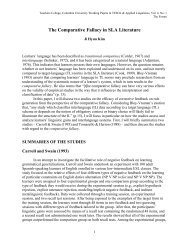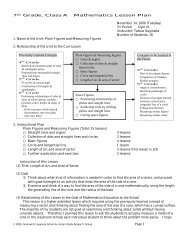UNICEF Mongolia - Teachers College Columbia University
UNICEF Mongolia - Teachers College Columbia University
UNICEF Mongolia - Teachers College Columbia University
You also want an ePaper? Increase the reach of your titles
YUMPU automatically turns print PDFs into web optimized ePapers that Google loves.
CHAPTER 2: THE TEACHING WORKFORCE<br />
1<br />
2<br />
3<br />
4<br />
• Hiring correspondence students with incomplete higher educaon who work part-me as<br />
teachers<br />
• Re-hiring rered teachers<br />
• Redistribung teaching hours: assigning addional teaching hours to teachers in subjects for<br />
which they have no training or license<br />
• Hiring professionals without a teacher educaon degree (“unqualified teachers”)<br />
• Accumulang teaching hours: assigning excessive teaching loads to teachers – 27-35 hours/<br />
week<br />
• Aracng qualified teachers who have another main source of income (farming, trade, private<br />
sector, etc.) to work for a few hours at school (“part-me teachers”)<br />
5<br />
6<br />
This study examined whether latent teacher shortage—in the form of hiring substute teachers—also<br />
occurs in <strong>Mongolia</strong>. The findings will be presented in Chapter 6 of this report.<br />
2.6. SUMMARY AND RECOMMENDATIONS<br />
The most important findings of this chapter are summarized in the following:<br />
TEACHERS IN MONGOLIA: AN EMPIRICAL STUDY ON RECRUITMENT INTO TEACHING,<br />
PROFESSIONAL DEVELOPMENT, AND RETENTION OF TEACHERS<br />
40<br />
(1) Composion of school staff: Close to one-third of the school staff is either working in school<br />
administraon or acts as support staff. School-based management and per capita financing was<br />
introduced in 1998. This explains why every school has a management team that consists of at<br />
least five members, regardless of school size: a principal, an educaon manager, a social worker,<br />
an accountant, and an inventory clerk and dormitory administrator. Despite external pressure<br />
to reduce non-educaonal staff over the past ten years, the two-to-one rao of staff to noneducaonal<br />
staff has remained remarkably constant.<br />
(2) Gender: Almost 96 percent of the teaching workforce is female, with a slightly higher proporon<br />
of male teachers working at lower and upper secondary school and a much higher representaon<br />
of men in school administraon.<br />
(3) Teaching experience and age: The teaching workforce is remarkably young, as 30.6 percent of<br />
all teachers have worked in schools for five years or less.<br />
(4) Qualificaons: According to stascal informaon from MECS, only 0.7 percent of teachers are<br />
currently unqualified. The proporon of unqualified teachers has diminished visibly over the<br />
past fieen years. In 1996/97, the rao of unqualified teachers was 12.1 percent of the teaching<br />
workforce. A closer examinaon, however, reveals a quadrupled expansion of higher educaon<br />
in the period 1996/97 to 2010/2011. Thus, the eradicaon of the category “unqualified<br />
teachers” does not necessarily imply that the quality of teachers has improved to the same<br />
extent as the increase in number of degree holders. A significant number of the small, private<br />
teacher educaon instuons are merely degree mills, while licensing programs do exist but do<br />
not necessarily help to improve the quality of teaching.<br />
(5) Rank and promoon: Approximately half of the teachers are currently in the lowest rank<br />
as regular teachers; this reflects to some extent the young age of the teaching workforce in



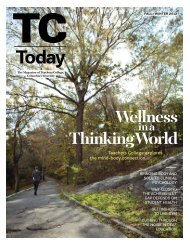

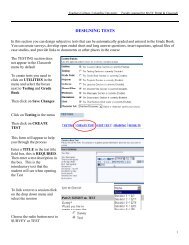


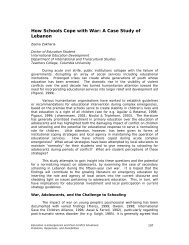
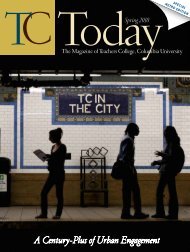
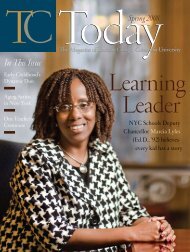
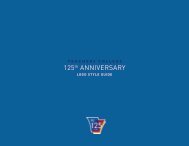


![TC Tod[...].pdf - Teachers College Columbia University](https://img.yumpu.com/27074883/1/190x252/tc-todpdf-teachers-college-columbia-university.jpg?quality=85)

